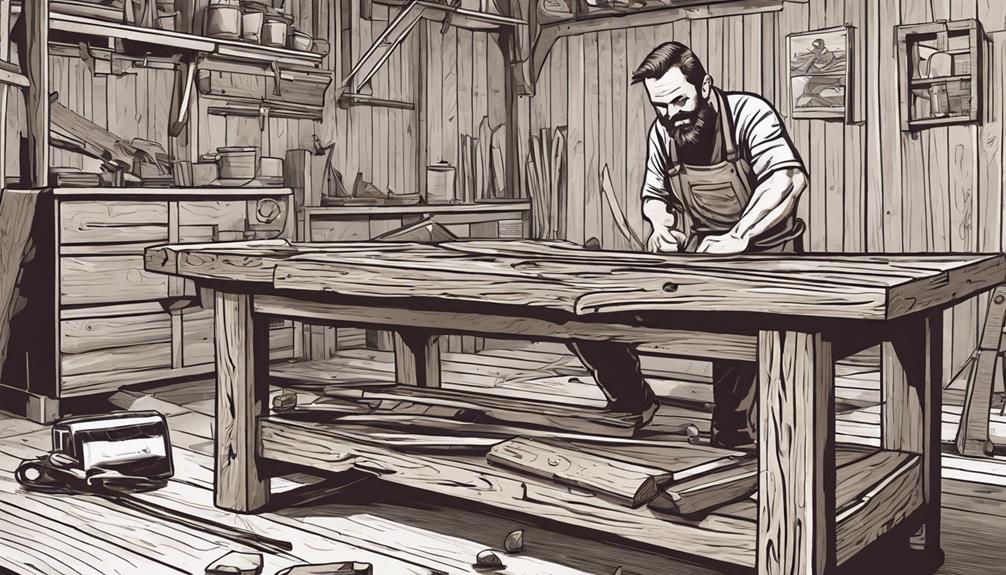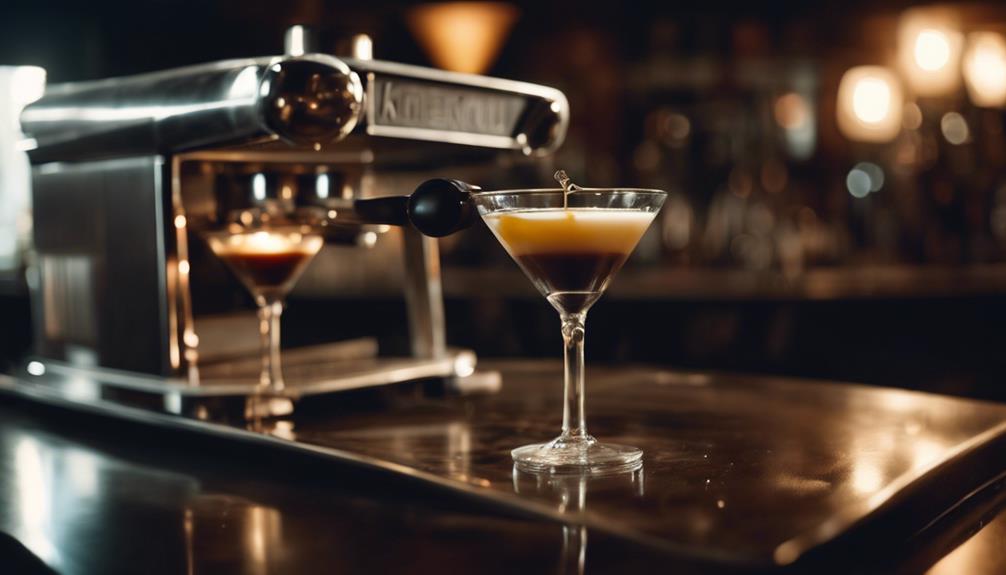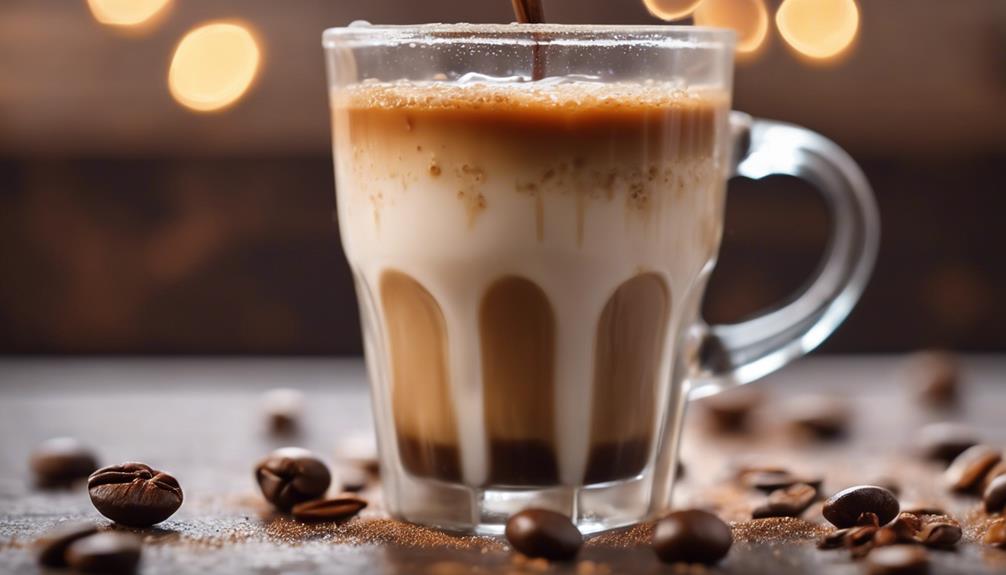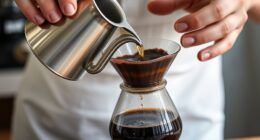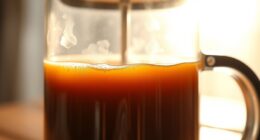You will absolutely love the Pumpkin Espresso Martini, a uniquely delicious fall cocktail that combines espresso, pumpkin puree, and coffee liqueur. With just 5 minutes of preparation and approximately 250-300 calories per serving, this autumn-inspired drink is ideal for Thanksgiving gatherings and festive celebrations. You can easily increase the recipe for larger groups, and also customize it with non-alcoholic, vegan, or low-calorie options. From the delightful flavors of pumpkin and espresso to the velvety texture of the creamer, each sip will transport you to the cozy embrace of fall – and there’s so much more to discover in this seasonal delight.
Key Takeaways
- This Pumpkin Espresso Martini combines espresso, pumpkin puree, and coffee liqueur for a delicious fall cocktail perfect for autumn festivities.
- With approximately 250-300 calories per serving, it's a relatively low-calorie indulgence for the season.
- Preparation is quick and easy, taking only about 5 minutes to make, and can be scaled up for larger gatherings.
- The flavor profile is rich and smooth, with the pumpkin puree adding autumnal warmth and creaminess to the strong espresso base.
Fall Cocktail Essentials
As you start planning your fall festivities, consider stocking up on these essential ingredients to create a seasonal cocktail menu that will impress your guests.
To craft the perfect Pumpkin Espresso Martini, you'll need a few key items. First, grab a cocktail shaker to mix and chill your ingredients. Next, pick up some pumpkin puree to add a rich, velvety texture to your drink. You'll also need a coffee liqueur, like Kahlua, to give your martini a deep, espresso flavor.
Don't forget to sprinkle a pinch of pumpkin pie spice on top for an extra burst of autumn flavor. With these ingredients in hand, you'll be well on your way to creating a fall-inspired cocktail menu that's sure to delight.
And the best part? This Pumpkin Espresso Martini is quick to whip up, taking only 5 minutes to prepare. So go ahead, get creative, and shake up a batch of these delicious drinks to serve at your next fall gathering!
Pumpkin Martini Recipe Details
You'll need to combine a few key ingredients to create the perfect Pumpkin Espresso Martini, with a unique blend of flavors and textures that will leave your guests wanting more.
To start, you'll need 2 oz of vodka, 3 oz of Kahlua, 3 oz of freshly brewed espresso, 2 oz of creamer, and 1 tbsp of pumpkin puree. This classic espresso martini gets a fall twist with the addition of pumpkin flavor, which pairs perfectly with the rich coffee flavor.
You can enhance the pumpkin flavor by adding a sprinkle of pumpkin pie spice during preparation or as a garnish. With these simple ingredients, you can create a delicious fall cocktail that's sure to impress.
The best part? It only takes about 5 minutes to prepare and serves approximately 250-300 calories per serving. Plus, the recipe is easily scalable, so you can double or triple the ingredients to serve multiple guests at your autumn gatherings.
With the right equipment, including a cocktail shaker, measuring tools, a strainer, and chilled martini glasses, you'll be well on your way to crafting the perfect Pumpkin Espresso Martini.
Autumn-Inspired Flavor Profile

With the ingredients combined, you're left with a rich, velvety cocktail that embodies the warmth and coziness of autumn, thanks to the perfect balance of espresso, pumpkin puree, and pumpkin pie spice.
The Pumpkin Espresso Martini is a true reflection of the fall season, with its inviting aroma and flavors that evoke feelings of comfort and nostalgia. The addition of Kahlua deepens the coffee flavor, making it a perfect choice for coffee lovers during the fall season.
| Flavor Component | Description | Impact |
|---|---|---|
| Espresso | Rich, bold, and smooth | Provides a strong coffee base |
| Pumpkin Puree | Sweet, creamy, and velvety | Adds autumnal warmth and coziness |
| Pumpkin Pie Spice | Warm, aromatic, and inviting | Evokes feelings of nostalgia and comfort |
The result is a cocktail that's not only delicious but also Instagram-worthy. With its creamy espresso texture and autumn-inspired flavors, the Pumpkin Espresso Martini is the perfect choice for your fall gatherings and Thanksgiving celebrations.
Easy Preparation Steps Guide
Now that you're ready to create your Pumpkin Espresso Martini, it's time to walk through the easy preparation steps.
You'll need to focus on a few key elements, including proper ice preparation, essential mixing techniques, and martini glass essentials, to guarantee a smooth and delicious drink.
Ice Preparation Tips
Chilling your Pumpkin Espresso Martini to perfection starts with preparing the right kind of ice, an essential step that can make or break the flavor and texture of your cocktail. To get it right, fill an ice cube tray with water and freeze it for several hours, ensuring you have enough ice to chill your cocktail shaker adequately.
For a more premium experience, use larger ice cubes or spheres to slow down dilution, allowing your cocktail to remain cold without watering it down quickly. If you want to elevate the visual appeal, consider freezing coffee or espresso in ice cube trays to create coffee-flavored ice cubes for serving.
Don't forget to chill your martini glasses by placing them in the freezer for about 10-15 minutes before serving to keep the cocktail cold longer. With these ice preparation tips, you'll be well on your way to crafting a chilled martini that's sure to impress.
Essential Mixing Techniques
To craft a perfectly balanced Pumpkin Espresso Martini, you'll need to master a few essential mixing techniques that will elevate your cocktail game.
Start by filling a cocktail shaker with a generous amount of ice to chill the ingredients effectively before shaking. Next, combine 2 oz of vodka, 3 oz of Kahlua, 3 oz of brewed espresso, 2 oz of creamer, and 1 tbsp of pumpkin puree directly into the shaker for a balanced flavor profile.
Shake the mixture vigorously for about 30 seconds to guarantee all ingredients are well combined and chilled while creating a frothy texture. This will help to emulsify the cream and vodka, giving your martini a silky smooth consistency.
After shaking, use a strainer to pour the mixture into chilled martini glasses, guaranteeing a smooth pour without any ice shards. Finally, for an extra touch, garnish the cocktail with a sprinkle of pumpkin pie spice or a few espresso beans on top to enhance presentation and flavor.
With these essential mixing techniques, you'll be well on your way to creating a delicious Pumpkin Espresso Martini that's sure to impress.
Martini Glass Essentials
You'll want to prepare your martini glasses in advance by storing them in the freezer or filling them with ice water, guaranteeing they're chilled to perfection when it's time to serve your Pumpkin Espresso Martini. This step may seem minor, but it makes a significant difference in the overall presentation and temperature of your cocktail.
When you're ready to serve, use a strainer to pour the mixed ingredients from the shaker into the chilled martini glass. This will prevent any ice shards from getting into your drink and guarantee a smooth, velvety texture.
To elevate your cocktail experience, consider using chilled stemmed glasses, which add an air of elegance and complement the seasonal theme of your pumpkin espresso martini.
Seasonal Garnish Ideas
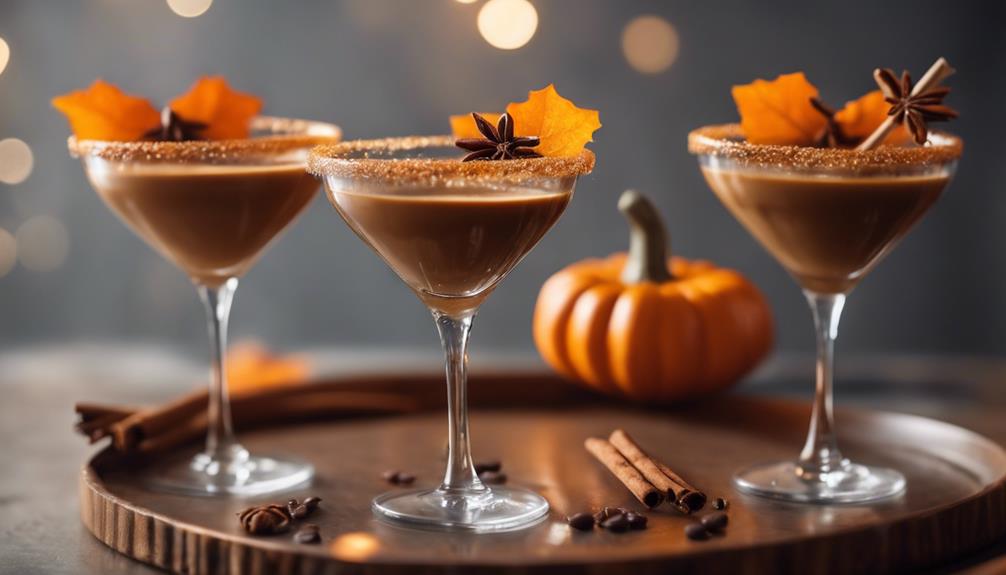
Five seasonal garnish ideas can elevate your Pumpkin Espresso Martini from ordinary to extraordinary. You can choose one or combine a few to create a unique look and flavor profile.
Here are some ideas to get you started:
| Garnish | Description |
|---|---|
| Pumpkin Pie Spice | Sprinkle a pinch to enhance autumn flavors and add visual appeal |
| Whipped Cream | Top with a dollop for a creamy texture and festive look |
| Espresso Beans | Add a few for a classic, elegant touch and to emphasize the coffee flavor |
| Caramel Sauce | Drizzle over whipped cream or around the rim of the glass for sweetness and decadence |
| Chocolate Shavings | Use for a rich, chocolatey finish that pairs well with pumpkin flavor |
These garnish ideas will take your Pumpkin Espresso Martini to the next level. You can experiment with different combinations to find your favorite. Remember, the key is to have fun and be creative!
Variations and Dietary Options
Now that you've mastered the art of garnishing your Pumpkin Espresso Martini, it's time to explore the many ways you can adapt this recipe to suit various tastes and dietary needs.
One of the best things about this cocktail is its versatility, offering plenty of variations to cater to different preferences.
If you're hosting a gathering with non-drinkers, you can easily transform the recipe into a non-alcoholic mocktail by substituting the vodka and Kahlua with coffee, flavored syrups, or espresso.
For those with dietary restrictions, rest assured that this recipe is gluten-free and can be made dairy-free with non-dairy creamers.
You can also make it refined sugar-free by using natural sweeteners instead of simple syrup.
Feel free to experiment with flavored vodkas, like vanilla or caramel, to enhance the richness of the cocktail without adding extra calories.
And, with a few tweaks, you can even make it vegan by using plant-based creamers and dairy-free toppings.
With these variations, you can enjoy your Pumpkin Spice Espresso Martini while catering to all your guests' needs.
Frequently Asked Questions
Can I Make a Virgin Version of the Pumpkin Espresso Martini?
You're wondering if you can make a virgin version of a certain fall-inspired drink. Absolutely, you can! Simply substitute the vodka with a non-alcoholic alternative, like cream soda or sparkling water, and keep the rest of the ingredients the same.
How Long Does It Take to Prepare This Fall Cocktail?
You're wondering how long it takes to prepare this fall cocktail? It'll take you around 10-15 minutes to mix and shake the ingredients, and that's including the time it takes to chill the martini glasses!
Can I Use Fresh Pumpkin Instead of Canned Puree?
"Oh, you think you're a rebel, don't you, wanting to use fresh pumpkin? Go ahead, waste your time roasting and pureeing, but honestly, canned is fine, and you'll get the same flavor with way less hassle."
Is the Pumpkin Espresso Martini Suitable for a Halloween Party?
You're wondering if this drink fits a Halloween party vibe, and the answer is yes! The pumpkin flavor and espresso kick will be a hit with your spooky celebration crowd, so go ahead and serve it up!
Can I Store the Martini Mixture in the Refrigerator Overnight?
"As you prep for the spookiest night of the year, you're wondering if your martini mixture can chill overnight. Yes, you can store it in the refrigerator, but give it a good stir before serving to revive the flavors and textures."
Conclusion
You've just conjured up the most divine, life-changing, and Instagram-worthy fall cocktail of the season – the pumpkin espresso martini!
With every sip, the warm, spiced flavors will transport you to a cozy autumn evening, surrounded by golden leaves and crackling fireplaces.
Your taste buds will do the happy dance, and your friends will beg for the recipe.
Trust us, this martini is the epitome of fall in a glass – you'll be obsessed!

